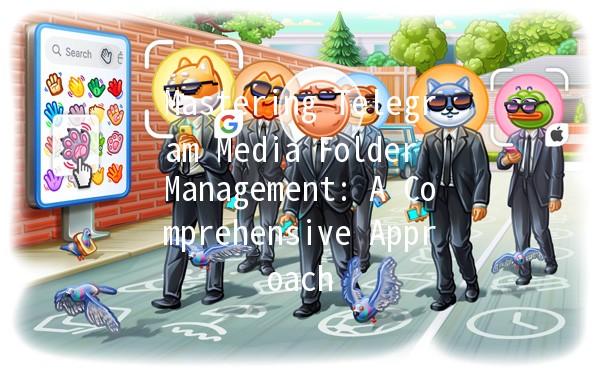Mastering Telegram Media Folder Management: A Comprehensive Approach 📂📱

In an age where instant communication has become paramount, Telegram stands out as a versatile messaging platform that not only facilitates conversations but also allows users to share various media files seamlessly. Whether you're a casual user, a content creator, or an organization, managing media files effectively can greatly enhance your experience on Telegram. In this article, we will explore the ins and outs of managing Telegram media folders, providing you with practical tips and strategies for optimizing your usage of this powerful application.
The Importance of Media Management on Telegram
As Telegram continues to grow in popularity, the importance of efficient media management cannot be overstated. The platform enables users to share photos, videos, documents, and other file types easily. However, with the sheer volume of media exchanged in chats or groups, it becomes increasingly challenging to keep things organized. Here are some reasons why effective media management is vital:

Getting Started: Understanding Telegram’s Media Folder Structure
Telegram automatically creates media folders based on the type of files you send and receive. Here’s a breakdown of the default structure:
Photos: This folder contains all images saved from chats. Each image is stored in its original resolution.
Videos: Similar to the photos folder, this one hosts all video files shared in your conversations.
Audio: This section stores all audio files, including voice messages and songs.
Documents: Any documents shared or received in Telegram will be found here, formatted as PDF files or other document types.
Stickers: Dedicated folder for saving sticker packs and individual stickers you’ve received or downloaded.
Understanding this folder structure is the first step toward mastering the management of your media on Telegram.
Organizing Media Folders
To begin efficiently managing your media files, consider the following strategies:
Telegram offers several settings that allow you to customize how media files are saved in your folders. To access these settings:
Go to `Settings` >`Data and Storage`.
Under the `Media AutoDownload` section, adjust the criteria for automatic downloads based on your connection quality (e.g., mobile data, WiFi).
By configuring these settings, you can prevent unnecessary downloads, which helps save space and keep your media folder organized.
Regularly auditing your media folders can help you identify and remove files you no longer need.
Identify Redundant Files: Navigate through your folders and look for duplicates or outdated files.
Use Telegram’s Search Feature: The search bar allows you to filter by media types, making it easier to locate specific files to delete.
Telegram offers cloud storage for all your media files. While they’re automatically stored in Telegram, you can also utilize external cloud services like Google Drive or Dropbox to back up important files, ensuring they’re safe even if you accidentally delete them from Telegram.
If you're frequently sharing specific types of media with certain contacts or groups, consider creating dedicated channels or groups. This practice reduces clutter and fosters better organization.
Example: Create a group specifically for storing photos from events, reducing the need to sift through unrelated chats.
Advanced Media Management Techniques
Once you have the basics down, consider these advanced techniques to further enhance your media management skills on Telegram.
Telegram has a plethora of bots designed to assist in file management. Here are a few example bot functions:
File Organizer Bots: These bots can help categorize files based on your preferences and can even delete duplicates.
Backup Bots: Utilize bots that help automatically back up your media files to cloud services for added security.
Several thirdparty applications complement Telegram by offering enhanced media management features. They can help aggregate your files across various platforms, making organization easier.
If you're techsavvy, you can create labels or tags for your media files. Utilizing a consistent tagging system allows you to easily sift through and retrieve files based on specific criteria, such as project names or events.
Best Practices for Telegram Media Management
To ensure your media files remain organized and accessible, we recommend following these best practices:
Developing a unique naming convention for your files can greatly enhance your ability to identify and sort through them. For example, include the date, content type, and project name in file names when saving or downloading them. Use underscores or hyphens for better readability.
Periodically review and clean your media folders. Setting a reminder to perform media cleanup every month helps keep your folders spick and span.
If you’re using Telegram for professional purposes, ensure all team members understand the organization strategy and media management practices. Clearly outline protocols and folders for shared media.
Effective media folder management is essential for anyone looking to optimize their Telegram experience. By understanding the app's folder structure, utilizing builtin features, and implementing advanced management techniques, you can ensure that your media remains organized, accessible, and secure. Follow the strategies outlined in this article to enhance your productivity, enjoy seamless collaboration, and better navigate the constantly evolving digital landscape.
With these tools and techniques at your disposal, managing media files on Telegram will not only become easier but also more efficient—allowing you to focus on what truly matters: connecting, collaborating, and sharing meaningful content with others. Embrace these strategies today, and take your Telegram experience to the next level!
Other News

如何在TelegramX中进行群组投票 🤖📊

Telegram安装时间优化 🚀📱

Telegram Mac版下載地址及其特色功能探索!
